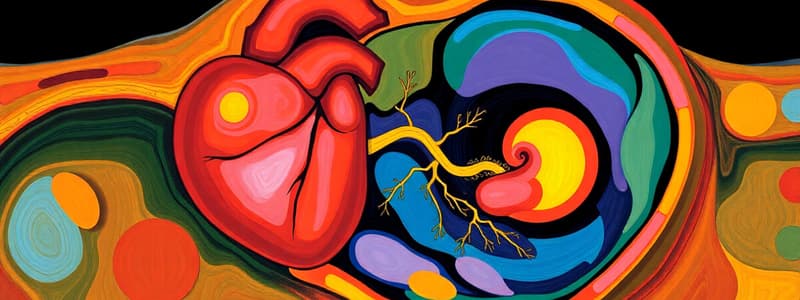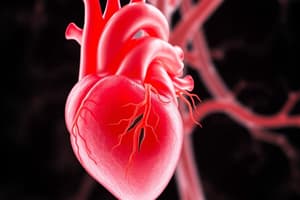Podcast
Questions and Answers
What is the role of the caudal pole in the cardiogenic area?
What is the role of the caudal pole in the cardiogenic area?
- It initiates the cephalic folding of the embryo.
- It is the initial site for venous drainage. (correct)
- It receives arterial blood from the dorsal aorta.
- It supports the formation of the brain vesicles.
What connects the tube to the dorsal side of the pericardial cavity?
What connects the tube to the dorsal side of the pericardial cavity?
- Dorsal mesocardium fold of the SHF (correct)
- Dorsal mesocardium
- Connecting stalk of the embryo
- Ventral mesocardium
Which of the following describes the heart primordia during development?
Which of the following describes the heart primordia during development?
- They initially start as a single tube and remain fused throughout development.
- They are paired tubes that fuse into a single structure except at their caudal ends. (correct)
- They develop into separate structures that do not fuse.
- They completely disappear during the formation of the gut tube.
What anatomical structure is the final destination of blood pumped from the first aortic arch?
What anatomical structure is the final destination of blood pumped from the first aortic arch?
During embryonic development, where does the heart and pericardial cavity first migrate?
During embryonic development, where does the heart and pericardial cavity first migrate?
What happens to the middle section of the dorsal mesocardium during development?
What happens to the middle section of the dorsal mesocardium during development?
What is the fate of the oropharyngeal membrane as the embryo develops?
What is the fate of the oropharyngeal membrane as the embryo develops?
What indicates the rapid growth of the central nervous system during embryonic development?
What indicates the rapid growth of the central nervous system during embryonic development?
What characterizes tricuspid atresia?
What characterizes tricuspid atresia?
What is a common consequence of ostium primum defect?
What is a common consequence of ostium primum defect?
Which condition is consistent with the presence of a membranous VSD?
Which condition is consistent with the presence of a membranous VSD?
Which of the following is NOT associated with tricuspid atresia?
Which of the following is NOT associated with tricuspid atresia?
What does the presence of a cleft in the anterior leaflet of the tricuspid valve usually indicate?
What does the presence of a cleft in the anterior leaflet of the tricuspid valve usually indicate?
What does the right ventricle supply blood to during its development?
What does the right ventricle supply blood to during its development?
Which pharyngeal arches are involved in the migration of structures related to the heart?
Which pharyngeal arches are involved in the migration of structures related to the heart?
What primarily causes the expansion of the primitive ventricles by the end of the fourth week?
What primarily causes the expansion of the primitive ventricles by the end of the fourth week?
What structure is formed by the medial walls of the expanding ventricles?
What structure is formed by the medial walls of the expanding ventricles?
What condition arises if trabeculation does not develop during ventricular formation?
What condition arises if trabeculation does not develop during ventricular formation?
Which of the following describes the effect of continuous growth of the myocardium during ventricular development?
Which of the following describes the effect of continuous growth of the myocardium during ventricular development?
What is the primary outcome of diverticulation and trabecula formation inside the ventricles?
What is the primary outcome of diverticulation and trabecula formation inside the ventricles?
During separation of the conus cordis, which crucial process occurs?
During separation of the conus cordis, which crucial process occurs?
Which of the following best describes the inheritance pattern of Holt-Oram syndrome?
Which of the following best describes the inheritance pattern of Holt-Oram syndrome?
Which gene is primarily associated with Holt-Oram syndrome and contributes to various developmental processes?
Which gene is primarily associated with Holt-Oram syndrome and contributes to various developmental processes?
What type of abnormalities are characteristic of Holt-Oram syndrome?
What type of abnormalities are characteristic of Holt-Oram syndrome?
Which of the following best describes the heart conditions associated with hypertrophic cardiomyopathy?
Which of the following best describes the heart conditions associated with hypertrophic cardiomyopathy?
Which signaling molecule is involved in the determination of left-sidedness in embryonic development?
Which signaling molecule is involved in the determination of left-sidedness in embryonic development?
Which factor contributes to the risk of sudden death in individuals with hypertrophic cardiomyopathy?
Which factor contributes to the risk of sudden death in individuals with hypertrophic cardiomyopathy?
What frequency describes the occurrence of Holt-Oram syndrome in live births?
What frequency describes the occurrence of Holt-Oram syndrome in live births?
What is the primary structural defect associated with dextrocardia?
What is the primary structural defect associated with dextrocardia?
What contributes to the formation of endocardial cushions in the atrioventricular canal after the closure of the septum primum?
What contributes to the formation of endocardial cushions in the atrioventricular canal after the closure of the septum primum?
Which of the following structures forms the ostium secundum?
Which of the following structures forms the ostium secundum?
What is the role of the four atrioventricular endocardial cushions?
What is the role of the four atrioventricular endocardial cushions?
Where do the two branches from the main stem of the pulmonary vein open into?
Where do the two branches from the main stem of the pulmonary vein open into?
Which sequence best describes the development of the septum primum?
Which sequence best describes the development of the septum primum?
What separates the primitive left ventricle from the bulbus cordis?
What separates the primitive left ventricle from the bulbus cordis?
At what stage do the four atrioventricular endocardial cushions become prominent?
At what stage do the four atrioventricular endocardial cushions become prominent?
What does the closure of the septum primum achieve in terms of blood flow?
What does the closure of the septum primum achieve in terms of blood flow?
Flashcards are hidden until you start studying
Study Notes
Cardiovascular System Development
- Venous drainage at the caudal pole initiates heart pumping.
- Early formation of the cardiogenic area occurs anterior to the oropharyngeal membrane.
- Closure of the neural tube leads to brain vesicle development and the central nervous system’s rapid growth, extending over the cardiogenic region.
- The heart develops from paired tubes that fuse into a single tube, with caudal ends embedded in the septum transversum.
- The outflow tract connects to the aortic sac and aortic arches, with the heart moving from the cervical to thoracic region.
Septum Formation
- By the end of the fourth week, four atrioventricular endocardial cushions form and fuse, creating the right and left atrioventricular canal.
- The canal initially connects only to the primitive left ventricle, separated from the bulbus cordis by the bulbo (cono) ventricular flange.
- Septum formation in ventricles occurs through the growth of myocardial tissue leading to ventricular expansion and trabeculation.
Cardiac Abnormalities
- Holt-Oram Syndrome results from TBX5 gene mutations, linking limb and heart defects, specifically atrial septal defects (ASDs).
- Hypertrophic Cardiomyopathy caused by mutations in sarcomere proteins can lead to sudden cardiac death.
- Dextrocardia represents an abnormality in cardiac looping that results in the heart being positioned on the right side of the thorax.
Specific Defects
- Ostium Primum Defect: Results from incomplete fusion of endocardial cushions, creating an atrial septum defect but maintaining a closed interventricular septum.
- Tricuspid Atresia: Characterized by the absence or fusion of the tricuspid valve, associated with several conditions like underdevelopment of the right ventricle, ventricular septal defect (VSD), and hypertrophy of the left ventricle.
Studying That Suits You
Use AI to generate personalized quizzes and flashcards to suit your learning preferences.



